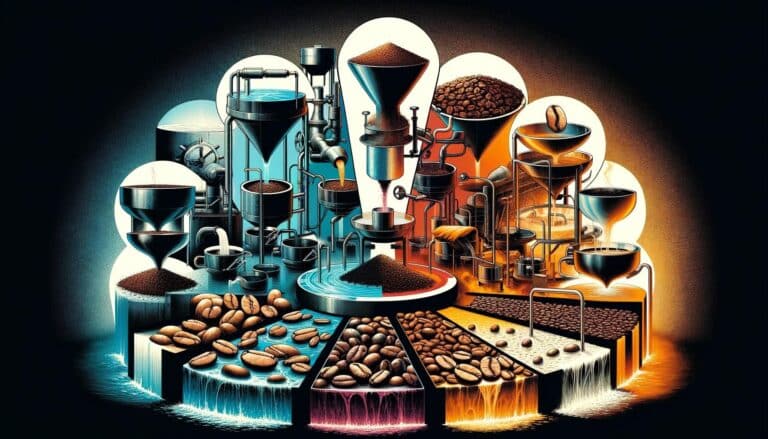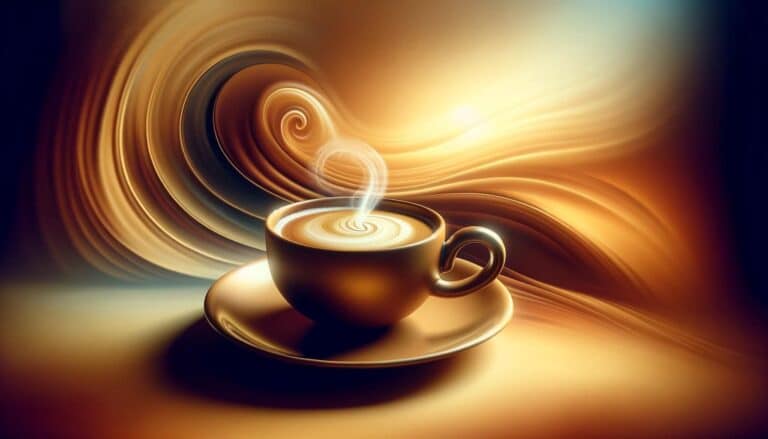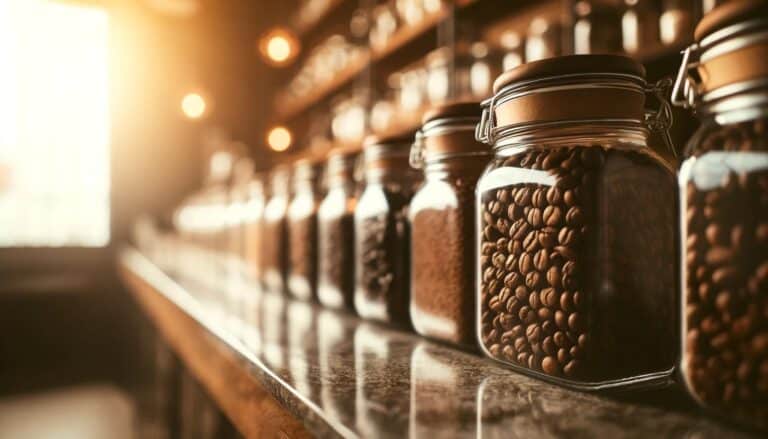Coffee, often referred to as the elixir of productivity and creativity, plays a pivotal role in the lives of millions worldwide. At the heart of a great cup of coffee are the beans, the foundation of flavor, aroma, and quality. The journey to a perfect brew begins with understanding and selecting the right coffee beans, a task that can seem daunting but is ultimately rewarding.
In this article, we delve into the art and science of choosing the best coffee beans for your brew. From the high-altitude farms of Ethiopia to the rich soils of Colombia, each bean carries its unique story and flavor profile. Numerous variables, such as the origin of the beans, the type of coffee plant, the processing technique, and the roasting level, affect the choice of beans. Each of these elements plays a crucial role in shaping the final taste of your coffee. Whether you’re a seasoned coffee aficionado or a curious beginner, understanding these factors will enhance your appreciation for coffee and guide you in selecting beans that cater to your personal taste preferences. Join us as we explore the world of coffee beans, helping you navigate the vast sea of options to find the perfect match for your next cup of coffee.
Understanding Coffee Bean Origins

The world of coffee is as diverse as it is flavorful, with each coffee-producing region offering its unique characteristics and nuances. Understanding these regions is key to selecting the right beans for your taste preferences.
African Coffee Origins:
- Ethiopia: Often regarded as the birthplace of coffee, Ethiopian beans are known for their bright, fruity, and floral flavors, often with a hint of wine or berry. They are typically light to medium in roasting to preserve their delicate notes.
- Kenya: Kenyan beans are prized for their vibrant acidity, full body, and rich fragrance. They often exhibit flavors of berry and citrus with a distinctive wine-like quality.
South American Coffee Origins:
- Colombia: Colombian beans are famous for their smooth, mild flavor and balanced acidity. They often have caramel or nutty notes, making them a popular choice for all types of coffee drinkers.
- Brazil: As the world’s largest coffee producer, Brazilian beans are known for their chocolatey, nutty flavors, often with a heavier body and less acidity. They are versatile and commonly used in espresso blends.
Central American Coffee Origins:
- Guatemala: Guatemalan coffee is renowned for its rich, full-bodied flavor with a balance of sweetness and acidity. Expect notes of chocolate, nuts, and sometimes a subtle smokiness.
- Costa Rica: Coffee from Costa Rica is often described as bright and full-bodied, with flavors ranging from fruity to spicy. The country’s diverse microclimates contribute to a wide range of flavor profiles.
Asian Coffee Origins:
- Indonesia: Indonesian coffees, such as those from Sumatra, are known for their full body and low acidity. They often have earthy, woody, or spicy flavors and are popular in darker roasts.
- Vietnam: Primarily known for robusta beans, Vietnamese coffee is typically strong, with a heavy body and a distinctive bitter flavor. It’s often used in blends to add strength and crema to espresso.
Each region’s unique climate, soil, altitude, and processing methods contribute to these distinct flavor profiles. By understanding these differences, you can begin to navigate the complex world of coffee with a more informed palate, ready to select beans that will delight your taste buds and elevate your brewing experience.
Types of Coffee Beans
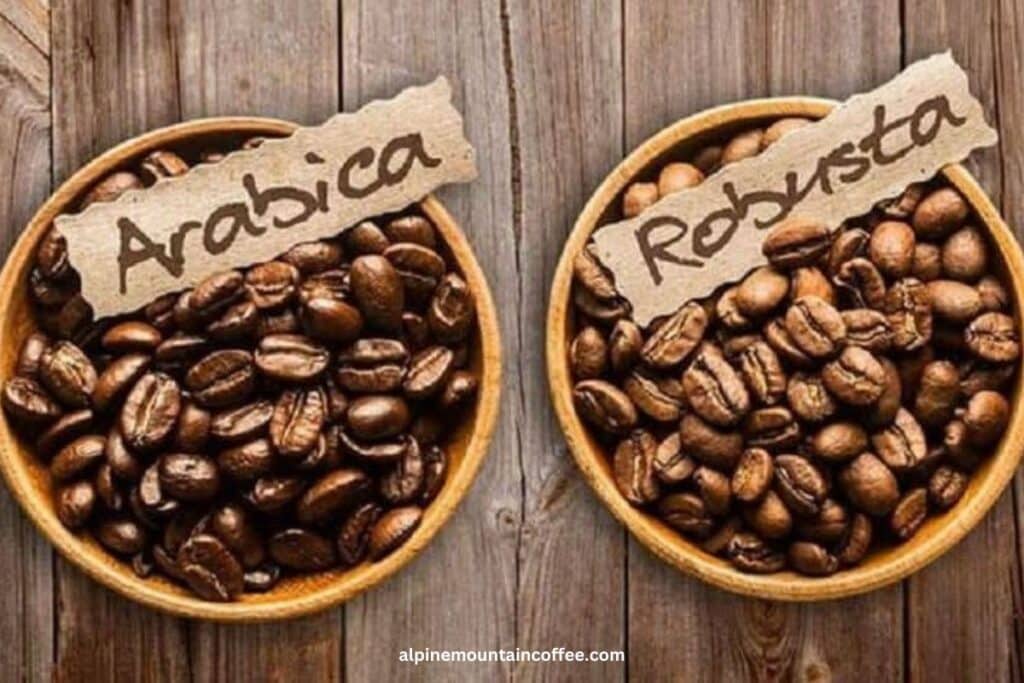
Coffee beans come in different varieties, each with its unique characteristics. The most common types are Arabica, Robusta, Liberica, and Excelsa. Understanding the differences among these can significantly enhance your coffee selection and brewing experience.
Arabica (Coffea arabica):
- Flavor: Arabica beans are prized for their delicate, nuanced flavors and aromatic complexity. They often have a sweeter, softer taste with tones of sugar, fruits, and berries. Higher acidity is also a hallmark, contributing to a winey quality in some varieties.
- Caffeine Content: Arabica beans have less caffeine compared to Robusta, typically around 1.2-1.5%.
- Typical Uses: Due to their superior flavor profile, Arabica beans are commonly used in specialty and artisanal coffees. They are ideal for a range of brewing methods, from drip coffee to espresso.
Robusta (Coffea canephora):
- Flavor: Robusta beans are known for their strong, bold flavor with a somewhat harsh and nutty aftertaste. They often have a grain-like overtone and can be described as woody or earthy.
- Caffeine Content: These beans contain higher caffeine levels, around 2.2-2.7%, which contributes to their bitter taste and makes them more resistant to pests.
- Typical Uses: Robusta is frequently used in espresso blends for its rich crema and strong flavor. It’s also popular in instant coffee products due to its lower cost and stronger flavor.
Liberica (Coffea liberica):
- Flavor: Liberica beans have a unique flavor profile with a somewhat fruity and floral taste, often accompanied by a woody or smoky aroma. The beans are larger and more irregular in shape.
- Caffeine Content: The caffeine content in Liberica is similar to or slightly higher than Arabica but lower than Robusta.
- Typical Uses: Liberica is less common than Arabica and Robusta. It’s a specialty variety often found in parts of Africa and Southeast Asia, appreciated for its unique taste.
Excelsa (Coffea excelsa or Coffea liberica var. dewevrei):
- Flavor: Often considered part of the Liberica family, Excelsa beans offer a tart, fruity profile, with light acidity. They’re known for their distinctive aromas, which can range from spicy to fruity.
- Caffeine Content: Excelsa beans have a caffeine content similar to Liberica.
- Typical Uses: Excelsa is used mainly to provide a tart, fruity lift in blends, adding complexity and depth. It’s relatively rare and is primarily grown in Southeast Asia.
Each type of coffee bean offers a distinct taste, caffeine level, and brewing suitability. Arabica and Robusta are the most commonly consumed, with the former being favored for quality and the latter for its robustness and efficiency in farming. Despite being less common, Liberica and Excelsa offer distinctive flavors that coffee lovers looking to venture outside of the mainstream varieties can seek out.
The Roasting Process and Its Impact

The roasting process is crucial in coffee production, as it significantly influences the flavor, aroma, and color of the coffee beans. Roasting levels range from light to dark, each bringing out different characteristics in the beans.
Light Roast:
- Flavor and Aroma: Light roast coffee beans are roasted for the shortest time, retaining much of their original flavor, which is largely determined by the bean’s origin. These beans have a higher acidity and exhibit more fruity and floral notes. The roast level also preserves the bean’s natural caffeine content.
- Ideal Brewing Methods: Light roasts are often preferred for manual brewing methods like pour-over and Aeropress, where the delicate flavors can be fully appreciated.
Medium Roast:
- Flavor and Aroma: Medium roast beans have a more balanced flavor, aroma, and acidity. The roasting process reduces some of the original bean’s brightness and begins to bring out deeper, sweeter flavors, often reminiscent of caramel or nuts.
- Ideal Brewing Methods: This roast is versatile and widely used, suitable for a range of brewing methods, including drip coffee makers, siphon coffee, and even espresso.
Dark Roast:
- Flavor and Aroma: Dark roast beans are roasted the longest, creating a bold, robust flavor. The beans lose most of their original characteristics and instead develop rich, dark chocolate or smoky flavors. The acidity is much lower, and the bitterness is more pronounced.
- Ideal Brewing Methods: Dark roasts are often preferred for espresso due to their strong flavor and ability to cut through milk in lattes and cappuccinos. They’re also commonly used in French press brewing.
Roast Level and Brewing Method:
- Each brewing method extracts different qualities from the coffee. Light roasts, with their complex and delicate flavors, are ideal for methods that allow for careful control of brewing time and temperature.
- Medium roasts, being the most versatile, can be enjoyed with almost any brewing method, providing a good balance between the bean’s intrinsic flavors and those developed during roasting.
- Dark roasts are well-suited for methods that extract coffee quickly, like espresso, as they bring out the rich, bold flavors that define these brewing styles.
In summary, the roasting process transforms the coffee beans from their raw state into the flavorful beans we use for brewing. The level of roast not only affects the taste and aroma of the coffee but also dictates the most suitable brewing methods to fully appreciate the unique characteristics of each roast. Understanding the impact of roasting can help coffee enthusiasts choose the right beans for their preferred brewing style and flavor preferences.
The Importance of Freshness
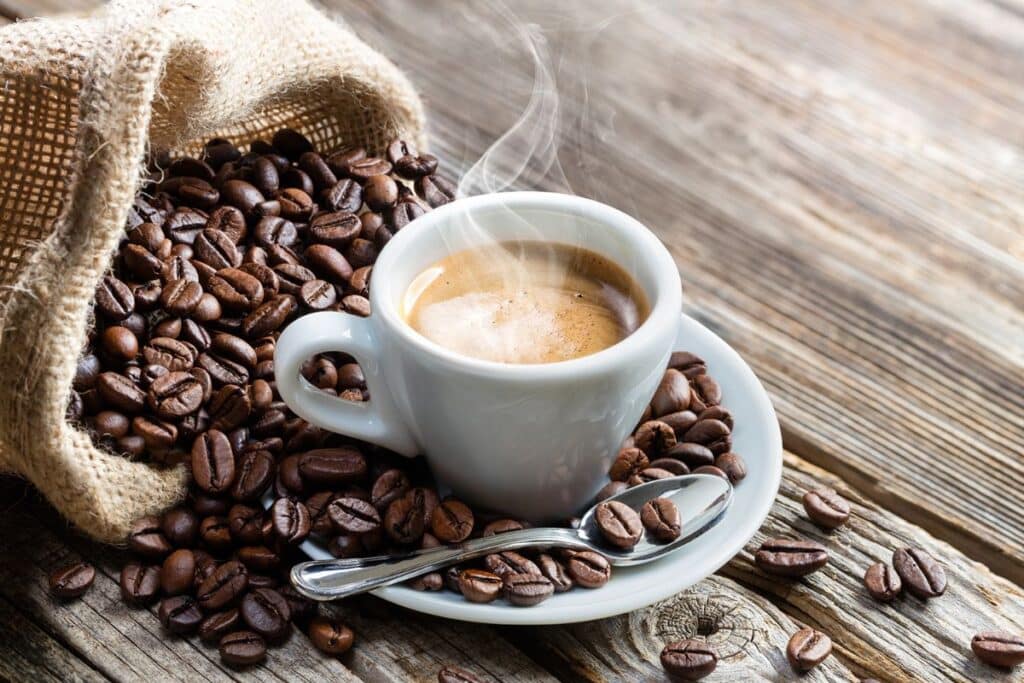
Freshness is a critical factor in the quality of your coffee brew. The journey from bean to cup is time-sensitive, and understanding how to maintain the freshness of your beans can significantly enhance your coffee experience.
Impact of Freshness on Brew Quality:
- Flavor and Aroma Preservation: Fresh coffee beans retain their essential oils and aromatic compounds, which are responsible for the coffee’s flavor and aroma. Over time, exposure to air, moisture, heat, and light can cause these oils to degrade, leading to stale and flat-tasting coffee.
- Carbon Dioxide and Extraction: Freshly roasted coffee beans release carbon dioxide, a natural by-product of the roasting process. This ‘degassing’ is important for optimal extraction. Beans that have degassed too much can result in a less dynamic brew.
Tips for Identifying Fresh Beans:
- Check the Roast Date: Look for a roast date on the packaging rather than a ‘best by’ date. Beans are generally freshest within two weeks of their roast date.
- Look for Signs of Freshness: Fresh beans should be slightly glossy from their natural oils, and a light squeeze should release a noticeable aroma.
- Purchase from Reputable Sources: Buy from specialty coffee shops or roasters who can provide information about the roast date and origin of the beans.
Storing Coffee Beans Properly:
- Airtight Containers: Store coffee beans in airtight containers to protect them from air, moisture, and light. Glass or ceramic containers with airtight seals are ideal.
- Cool, Dark Place: Keep the container in a cool, dark place, away from direct sunlight and any heat sources.
- Avoid the Fridge or Freezer: Contrary to popular belief, storing beans in the fridge or freezer can introduce moisture and lead to flavor degradation. It’s best to store them at room temperature.
- Buy in Small Quantities: Purchase coffee in small amounts that you can use within a few weeks to ensure freshness.
By prioritizing freshness in your coffee beans, you can ensure that each cup you brew is vibrant, flavorful, and aromatic. Fresh beans can transform your coffee experience, offering a richer and more enjoyable taste profile than their older counterparts.
Grind Size and Brewing Method

Grind size is a crucial factor in brewing coffee, as it directly affects the extraction process and the final flavor of the coffee. Different brewing methods require different grind sizes for optimal extraction.
Matching Grind Size to Brewing Method:
- Coarse Grind: Ideal for French press, cold brew, and percolator brewing methods. The large grind size allows for a longer steeping time without over-extracting, which is essential in these methods.
- Medium-Coarse Grind: Suitable for Chemex or other pour-over methods with a longer brew time. This grind size ensures a balanced extraction.
- Medium Grind: Perfect for drip coffee makers and siphon coffee. The medium grind allows for a balanced extraction in the relatively short brew time of these methods.
- Medium-Fine Grind: This grind size works well with Aeropress and some pour-over methods like the Hario V60, which have a shorter contact time between the water and the coffee.
- Fine Grind: Used for espresso machines. The fine grind creates resistance to the water being forced through, which is necessary to produce the characteristic rich and concentrated espresso shot.
- Extra Fine Grind: Ideal for Turkish coffee, which requires powder-like coffee grounds to create its traditional texture and flavor.
Impact of Grind Size on Extraction and Flavor:
- Extraction Rate: Grind size affects how quickly flavors are extracted from the coffee grounds. Finer grinds have more surface area in contact with water, leading to quicker extraction. Conversely, coarser grinds have less surface area and require longer extraction times.
- Under-Extraction vs. Over-Extraction: If the grind is too coarse for the brewing method, the coffee may be under-extracted, resulting in a weak, sour cup. If the grind is too fine, it can lead to over-extraction, making the coffee taste bitter and astringent.
- Balanced Extraction: The right grind size allows for a balanced extraction, where the desirable flavors are extracted efficiently without the negative flavors that come from over-extraction.
In summary, the correct grind size is integral to brewing a great cup of coffee. It ensures that the coffee is neither under-extracted nor over-extracted, achieving the desired strength and flavor profile specific to each brewing method. Understanding the relationship between grind size and brewing technique is key to customizing your coffee experience to your preferences.
Organic and Fair-Trade Options

In the realm of coffee, the terms ‘organic’ and ‘fair-trade’ are increasingly prominent, reflecting a growing awareness of environmental and social responsibility in coffee production. Understanding these concepts can guide consumers in making choices that align with their values and possibly impact the quality and sustainability of their coffee.
Organic Coffee Beans:
- Environmental Benefits: Organic coffee is grown without synthetic fertilizers or pesticides, which is better for the environment. This approach to farming helps maintain soil health, preserve local ecosystems, and protect water quality.
- Health Considerations: For consumers, organic coffee means reduced exposure to residues of chemical pesticides and fertilizers.
- Flavor and Quality: Some argue that organic coffee offers a purer and more natural flavor, as the beans are grown in a more balanced and chemical-free soil environment. However, other elements like origin, variety, and roasting can also affect flavor.
- Sustainability: Organic farming practices are generally more sustainable, promoting biodiversity and ecological balance.
Fair-Trade Coffee Beans:
- Social and Economic Benefits: Fair-trade certification aims to provide better prices, decent working conditions, local sustainability, and fair terms of trade for farmers and workers. It ensures that coffee producers receive a fair price for their beans, which helps to improve their living conditions.
- Direct Impact on Communities: Fair-trade practices can lead to more investments in local communities, such as improved education, healthcare, and farming infrastructure.
- Consumer Awareness: Purchasing fair-trade coffee raises consumer awareness about the origins of their coffee and the conditions under which it was produced.
Impact on Coffee Quality and Sustainability:
- Quality Assurance: Both organic and fair-trade certifications have strict standards that can lead to higher quality produce. Farmers engaged in these practices often invest more care and attention in their coffee crops.
- Long-Term Sustainability: By supporting environmentally friendly and socially responsible coffee production, consumers contribute to the long-term sustainability of the coffee industry. This approach can preserve the quality and availability of coffee for future generations.
In conclusion, choosing organic and fair-trade coffee beans has broader implications beyond just the cup of coffee. It supports environmentally friendly farming practices, ensures fair compensation and working conditions for coffee producers, and promotes a sustainable future for the coffee industry. While these options might come at a higher cost, they offer a way for consumers to align their coffee consumption with their ethical and environmental values.
Experimenting with Blends and Single-Origin Beans

The choice between blends and single-origin coffee beans is a significant aspect of the coffee experience. Each offers a unique journey in taste and complexity, and understanding these differences can be a delightful exploration for any coffee enthusiast.
Single-Origin Beans:
- Definition: Single-origin coffee is sourced from one location, which can be a specific country, region, or even a single farm. These beans reflect the specific geographic and climatic conditions of their origin.
- Flavor Profile: The flavor of single-origin coffee is distinct and characteristic of its growing area, offering a unique and consistent taste. These coffees often have a more pronounced flavor profile, highlighting specific notes such as floral, fruity, or earthy.
- Seasonality: Single-origin coffees can change seasonally, offering a diverse range of flavors throughout the year.
Blends:
- Definition: Blends consist of beans from multiple origins combined to create a specific flavor profile. Blenders mix various single-origin beans in different proportions to achieve a consistent taste.
- Flavor Consistency: The primary goal of a blend is to produce a balanced and consistent flavor, often smoothing out the unique characteristics of single-origin beans. Blends are designed to create a harmonious flavor that is enjoyable to a wide range of palates.
- Versatility: Blends are typically crafted to perform well across various brewing methods and are often favored in espresso due to their balanced and robust profile.
Encouraging Experimentation:
- Personal Preferences: The choice between single-origin and blends is subjective and depends on personal taste preferences. While single-origin coffees offer a distinct and pure flavor profile, blends provide a balanced and consistent taste.
- Exploration and Discovery: Experimenting with different single-origin coffees can be a journey of discovery, unveiling the diverse flavors influenced by different growing conditions. Similarly, exploring blends can reveal how different beans interact to create complex and harmonious flavors.
- Brewing Techniques: The brewing technique can also affect the choice of coffee. Experimenting with different coffees in your preferred brewing method can lead to finding the perfect match for your taste.
In summary, both single-origin beans and blends offer unique and enjoyable coffee experiences. Single-origin coffees allow you to explore the distinct flavors of specific regions, while blends offer a consistent and balanced profile. Experimenting with both can expand your coffee palate and help you discover what you truly enjoy in a cup of coffee.
Practical Tips for Buying Coffee Beans
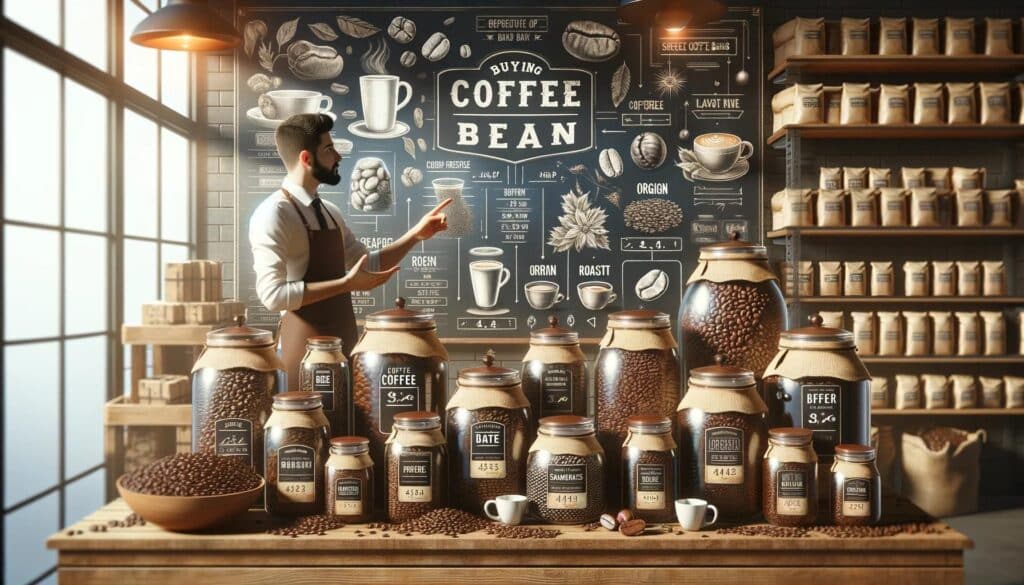
Choosing where to buy coffee beans and deciding between pre-packaged versus freshly roasted beans can greatly impact the quality of your coffee experience. Here are some practical tips to help you navigate these choices.
Where to Buy Quality Beans:
- Local Roasters: Purchasing from local roasters often guarantees fresher beans, as they’re typically roasted in smaller batches. Local roasters can provide detailed information about the origin, roast date, and characteristics of their beans.
- Online Specialty Stores: For a wider selection, online specialty coffee shops offer beans from various roasters and regions. They often provide detailed descriptions and brewing recommendations for their products.
- Supermarkets: While more convenient, supermarkets may not offer the freshest options. However, some do stock beans from reputable local or national roasters. Look for packaging with a roast date and avoid those only listing a ‘best by’ date.
Pre-Packaged vs. Freshly Roasted Beans:
- Pre-Packaged Beans:
- Pros: Convenient and widely available. They often come in airtight packaging to prolong freshness.
- Cons: The beans may not be as fresh, losing some flavor and aroma. The roast date is often not provided, making it difficult to assess their freshness.
- Freshly Roasted Beans:
- Pros: Offer peak flavor and freshness. Roast dates are usually provided, ensuring you get the freshest beans possible. Freshly roasted beans also allow for a more customizable coffee experience.
- Cons: May require more effort to source, as they are typically found at specialty shops or local roasters. They can also be more expensive and have a shorter shelf life due to their freshness.
Additional Tips:
- Sample Different Roasters: Try beans from different roasters to discover your preferences. Many roasters offer sample packs, allowing you to explore various flavors and roast profiles.
- Storage: Once you purchase your beans, store them properly to maintain freshness. Use an airtight container and keep it in a cool, dark place.
- Seasonality: Be aware of the seasonality of coffee beans. Different regions harvest at different times of the year, and this can influence availability and flavor profiles.
Buying coffee beans is a balance between convenience, freshness, and personal taste preferences. Exploring options from local roasters, online specialty stores, and even supermarkets can broaden your understanding and appreciation of different coffee beans. Whether you choose pre-packaged or freshly roasted beans, proper storage and an awareness of roast dates are key to ensuring a quality coffee experience.
Conclusion
In our journey through the intricate world of coffee, we’ve explored various aspects that contribute to making an exceptional cup. To recap the key points:
- Understanding Coffee Bean Origins: The origin of coffee beans greatly influences their flavor profiles. Beans from Africa, South America, Asia, and Central America each offer unique tastes and aromas.
- Types of Coffee Beans: Different types of beans, such as Arabica, Robusta, Liberica, and Excelsa, each have distinct flavors and caffeine contents, shaping the experience of your brew.
- The Roasting Process: Roasting levels, from light to dark, significantly affect the flavor and aroma of coffee beans. Each roast level is suited to different brewing methods.
- Freshness: The freshness of coffee beans is paramount in determining the quality of your brew. Proper storage and awareness of roast dates are essential for maintaining their best qualities.
- Grind Size and Brewing Method: The grind size should match the brewing method to ensure proper extraction, affecting the overall taste and strength of the coffee.
- Organic and Fair-Trade Options: Choosing organic and fair-trade beans supports sustainable and ethical coffee production, contributing to the quality of your cup and the well-being of coffee-growing communities.
- Experimenting with Blends and Single-Origin Beans: Both single-origin beans and blends offer unique experiences. Experimentation can lead to discovering personal preferences in flavor and aroma.
- Buying Coffee Beans: Quality beans can be found at local roasters, online specialty stores, and supermarkets. The choice between pre-packaged and freshly roasted beans depends on your preference for convenience versus freshness.
Coffee is not just a beverage; it’s an experience that encompasses a rich tapestry of flavors, aromas, and origins. Each step in the process of selecting, brewing, and enjoying your coffee contributes to the overall experience. We encourage you to explore and enjoy the diverse world of coffee. Experiment with different origins, roasts, and brewing methods to find your perfect coffee bean. Remember, the best cup of coffee is the one that aligns with your personal taste and brings you joy in every sip. Happy brewing!
